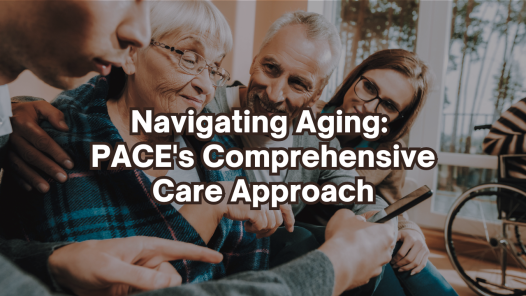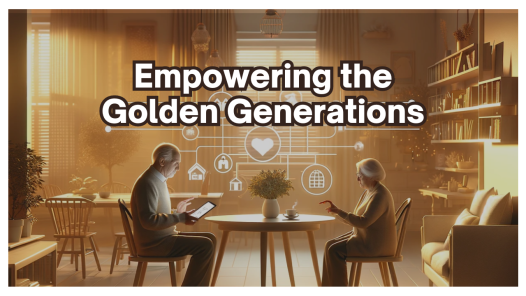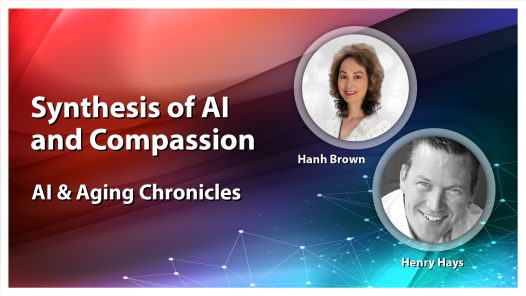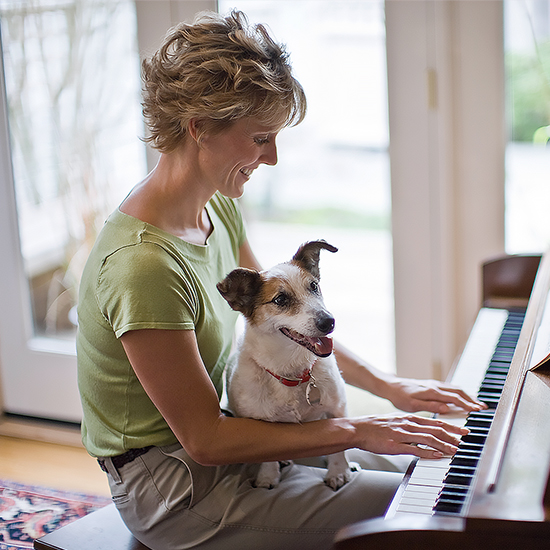
Emily Johnson is the Founder and Creative Director of StrongerU Senior Fitness. The first senior fitness certification globally to empower recreation, fitness, and wellness professionals and senior-serving organizations such as retirement communities and senior centers to deliver quality, safe, effective, and engaging fitness experiences through monthly pre-choreographed class content. She is on a mission to help seniors stay physically strong, intellectually sharp, and socially connected.
Topics Discussed:
- The current state of fitness in senior living
- Misconceptions about aging and exercise – ie. Gentle exercise and stretching
- How focusing on fitness can help senior living orgs to succeed post pandemic
- Where to start for senior living orgs wanting to elevate their fitness offering
- Where to go next if you already have a pretty good fitness offering
Emily’s LinkedIn: https://www.linkedin.com/in/emily-johnson-strongeru/
Transcription:
Hanh: 0:58
Today on Boomer Living, Emily Johnson joins me to discuss senior fitness and exercise as the founder and creative director of StrongerU Senior Fitness. She’s an expert on how to empower recreation, fitness and wellness within the retirement communities and senior centers. Emily, thank you so much for joining me today.
Emily: 1:20
Thank you so much for having me. I’m really excited to have a conversation with you.
Hanh: 1:24
So I’m eager to hear about your story and mission to help seniors, state physically strong, intellectually sharp and socially connected. So welcome.
Emily: 1:33
Yes. Thank you.
Hanh: 1:35
So can you tell us about your journey and how you got here?
Emily: 1:39
Yeah. I’ve beem in the senior living industry now for over a decade, it actually happened by accident. I had no intentions of ever working with older adults. I actually wanted to be a dentist and it was a volunteer opportunity that opened my eyes to working with this incredible population. And once I found senior living, I was really impressed. I really enjoyed my roles working with the older adults who were living in the retirement communities, where I worked in the recreation department and had just a great opportunity to start to enhance their lives, learn about them and give them a really really holistic offering.
Hanh: 2:15
So in your opinion, what what is the current state of fitness in senior living?
Emily: 2:21
Yeah, that’s a great question. Unfortunately, I believe the state of fitness and senior living is not at a great spot. It definitely has a whole lot of potential, which is one of the reasons I was excited to talk to you today, is to share that message of the potential. And right now fitness is not regulated in North America, not regulated in most of the world. So as a result of that, we don’t have guidelines in place for what is required of a person teaching senior fitness. So a lot of times, especially in retirement living long-term care skilled nursing we have individuals who are getting on the job training, so to speak. They may be getting a piece of paper that’s been passed down from individual to individual in the role, and they’re teaching the same five, six, seven, 10 exercises to the older adults they work with, but doing so with very little training to back them up.
Hanh: 3:17
So are those common misconceptions that you see around aging and exercise, for example, some people might think seniors are only capable of gentle exercise and stretching? So what can we do to help break these misconceptions?
Emily: 3:31
Yeah, absolutely. I think this part partly comes from that lack of understanding or education on what I should be doing with an older adults. we believe that as we age, we get more frail and weak and we have to take it easy, and that’s just really not the reality. The reality is that older exercisers can gain muscle and physical activity at the same rate or similar rate as younger exercisers. So when we look at the physical activity guidelines for older adults, it says we need to be achieving 150 minutes of moderate to vigorous intensity aerobic activity, and at least two days per week of muscle and bone strengthening. And it says nothing about gentle exercise or stretching being recommended, yet, we see that is a lot of what is offered, and I think that comes from people just not knowing how to safely reach those intensities or how to safely target all of the major muscle groups. So they default to something that is in their minds safe where they’re not going to injure the people that they care about. Of course they want to offer something that’s going to be safe, and if they have information to do more than they would do more, but I think that’s where we have a bit of a gap.
Hanh: 4:42
And often, if a person is under some kind of regimented exercise to workout, it’s always advised to consult with your doctor to make sure that it’s in accordance of their abilities and strength. So I think it’s wonderful regardless of your level of ability is, obviously check with your doctor and always maintain a healthy, strong, physical, active lifestyle, right? Because the fact that in my opinion, with the mess that we’re in being shut down, I think at least for myself, people are wanting to thrive and to continue to be active because you have to get over this hump, and if you stay shut down physically, mentally, oh, it’s very heavy on your mental health and wellbeing. So I’m a believer of health and wellness, staying active to whatever capacity that you can and be creative during this time.
Emily: 5:41
Yeah, and it’s, that’s part of the, you hit it right on the head for sure with that, because a lot of people think that a lot of the negative consequences that we see as we age are due to increasing in age, but a lot of time, it’s just due to an increase in inactivity. Naturally, as we go from our childhood years to high school, university, into the workforce, with families are our natural lifes, and we just tend to slow down. We work at a desk or, we go into retirement and we’re not going out to that active job that we may have had once, and when we slowed down, our bodies realized, “Hey, we don’t need this cardiovascular capacity anymore, or these strong muscles to lift things.”, and so your body is not going to put in the calories or put in the effort to maintain those strong muscles, and so we think, “Hey, they’re just getting older. They’re just slowing down.” But really they have a chance to combat that by staying active and continuing to exercise and being physically active.
Hanh: 6:37
And when you say slow down, in my opinion, if your body slows down, so will your mind, and you don’t want that. Okay. I always believe, at whatever capacity that you can, obviously, whatever you used to do and you are chest, let’s say getting back into a new routine, ease into it. No one is suggesting, kill yourself while you’re at it. Just do it in a healthy pace that your body is able to and whatever capacity that you can. So that’s great.
Emily: 7:03
We all have to start somewhere.
Hanh: 7:04
Yeah. Yeah. So I’m sure there are some senior communities out there that already have a robust fitness offerings for their residents. So where do they go next and how can they take it to the next level?
Emily: 7:16
Yeah. Great question. Um, I’d mentioned that the state of fitness and in retirement, living it’s a little bit dire, but there are some communities, organizations who are doing a phenomenal job, and for them, there’s always an opportunity to improve and get even better. So that’s where earlier, when you mentioned about being intellectually sharp and socially connected, we had this great opportunity during a 30 minute 45, 60 minute fitness class to not only work on the body, but work on the brain. The World Health Organization put out there risk factors for reducing the risk of dementia, and being physically active was the number one way that you can help to stave off dementia and Alzheimer’s and another, things that are going to bring down that capacity to continue to learn and to be intellectually engaged. So when we are physically active, we maintain that capacity, and one way we can do this is by mixing it up, having a lot of variety in our programs. Too often, I’ve sat in a fitness program where we did the same exercises day in and day out, or the instructor just counted to 10, where if we take those movements that we would normally do and create a combination out of them, whenever we have a combination, we have to use our brains to figure out, okay, what’s happening within this combination, and we have to put the pieces together and that really challenges us intellectually. There’s also an opportunity to be socially connected as well, maybe not right now, maybe we’re doing virtual fitness or we’re doing it in the hallways or in the doorways, but there is, a, still an opportunity to be social and have a fun element to the program.
Hanh: 8:53
Very true. I think nowadays all of what you describe very important, but I think we’re also having to add the layer of being creative, because it’s not as readily available. Everything surrounding wellness engagement activities are either at a limited capacity or to none, but it takes creativity to open all those new doors; very important right now. So now let’s say physical fitness, as we know, have, it has major positive effects on your mental health. So do you think this may be even more true for our seniors?
Emily: 9:30
Yes. Absolutely. Yeah. Just even when you’re physically active, there’s all sorts of chemical reactions that happen in our brain that just make us happier as it is, but there’s also the effects of you feeling better physically and being able to more successfully interact with your environment, that is going to just make you feel happier when you don’t have to ask for someone to give you a hand with the door, or you don’t have to be afraid of going out to lunch with your friends, because you’re not sure if you’ll be able to get off the toilet. Now, these aren’t very glamorous things to think about, but these are real concerns for some older adults.
Hanh: 10:03
Do you think this may be exasperated by the pandemic and will focusing on fitness help senior living organizations succeed in a post COVID world?
Emily: 10:13
Yes, absolutely. Unfortunately there’s a lot of confusion about what is retirement living, what is skilled nursing. People don’t have a great understanding of what the industry is as it is. I was reading a really cute, um quote from Dick van Dyke, and he goes through the reasons why he exercises throughout the different decades of his life, and he says in his eighties, he exercised to avoid assisted living. So this is post pandemic, Dick van Dyke, a beloved character for the generations that we’re looking to work with within then senior living, and he’s saying that he stays active to avoid assisted living. Now, me being very familiar with assisted living independent living, I know that this is a place where people can go to thrive, to be rid of having to do their own laundry or cook their own meals and have a, a great life. But if we have senior living organizations who can better utilize their fitness program, then they can truly show that coming to a senior living community can be a place where you can get stronger. I’ve seen so many seniors move into our communities that I’ve worked with in the past, and their family barely recognizes them a few months later because they have taken part in the fitness program. They look like a new person. They’re never in their suite. Their family can never get ahold of them. And I think if we take it a step further and we actually show data around this, so things like fitness testing to show, “Hey, every single one of the individuals who moves into our building takes part in a fitness test. Taking part in exercise at least once a week, we’re seeing these types of improvements in our residents.” That data can be huge for rebuilding a reputation in the post COVID world.
Hanh: 11:52
And there’s a lot of cleaning up to do, right, or rebuilding to do. I think everything that you’re describing is very true. Often it may be difficult to get, your loved one, if they haven’t started already years ago in living a healthy lifestyle, it’s not too late to start, but let’s say they haven’t already, you got some convincing to do once they are in the community, but think what’s wonderful is that, more than likely their environment are people in the same place in life. So you have the component of socialization, even if you don’t even like working out, but the fact that you with other friends, for the social aspect of it. So I think it’s wonderful and it can grow on you. So I think obviously for folks that have already been active and leading a healthy lifestyle, that’s like a perfect fit, but it’s definitely a value proposition that needs to be amplified. That is what independent living senior living and, to some capacity assisted living. It’s about thriving continuing to live and being healthy to the best that you can given whatever health conditions that you’re at.
Emily: 13:03
Yes, I definitely agree.
Hanh: 13:04
What is your biggest strength that enables you to have a unique, impactful effect on older adults?
Emily: 13:11
Yeah. I think it’s working with hundreds of adults and older adults and finding out what works and what doesn’t, and really that’s the program content that are StrongerU Senior Fitness instructors use. So I’ve had to developed content to give to instructors so they can just learn it and they can teach it exactly as outlined and offer these dynamic programs that I’ve been talking about. So often when I talk to someone who’s struggling with their fitness program, they say, “Emily, I just really don’t know what to teach. I went to Google, I went to YouTube and I’m not sure if these are the right exercises to be using or how to put them together.” So that’s what StrongerU Senior Fitness does as the first global senior fitness course to offer 30 minutes of ongoing content every single month is we take out that work. We put it together for them, so they can just deliver that dynamic program to the seniors they serve.
Hanh: 14:05
Wonderful. And of course there’s not a program that fits all, right? It’s robust enough in tailor or able to tailor to individuals’ ability, so I think that’s very important. For ones that wanting to start, but just doesn’t have that motivation, perhaps they’ve gone through a tough spot in their lives, right? Maybe a loss of a spouse and also having difficulty acclimating to the new living arrangements. How do you get them motivated to get out and participate and stay active?
Emily: 14:38
Yeah, great question. It all starts with the why, “What is the reason why?” If I had a dollar for every time, a older adult told me, “Oh, honey, I’m 86, I can’t do that anymore.” “Or I’m 90, I can’t do any anymore.” And then on the flip side, I had an 86 year old or a 90 year old who was thriving and doing whatever I was offering. It’s really about getting to know what’s important for them. Sometimes they have barriers up and fears. They don’t want to go to the exercise class because they think it could be dangerous. Where that, and that’s where you brought up earlier, that they should always speak to their doctor first, but before taking part in an exercise program, and if they have a great doctor, that doctor is probably going to jump for joy. “Yes, you should get physically active. Definitely go to that exercise class.” Typically it’s only after an individual has undergone an operation or a surgery that they really have any limitations when it comes to fitness. So it’s really about sitting down with that person and finding out what’s important to them. Is there a trip coming up? Maybe not now, but is there a trip coming up in a year where they want to go to their granddaughter grandson’s wedding at a, a Mexico resort and they want to keep up with the family. They don’t want to feel like a burden that they’re slowing down their family and friends. If an older adult told me that was their goal, great, I’ve got the plan for you. You’re going to join our walking club. You’re going to come to our muscles and moves twice a week, and we’re going to get you in really great shape to be running around that resort. If you tie it back to their “Why”, that’s how you get them to give it a try and get involved.
Hanh: 16:05
I love it. I love it. Have them set goals and know their “Why”, and you can be instrumental for them to achieve their “Why” and their goals. And I think that applies to you and I. Sometimes it is difficult at any age to get motivated, because it requires us to be creative nowadays, and to be honest with you there’s so many things that you can work out at home. Obviously. I don’t know where you’re at, like in Michigan is like 20 something degrees right now, so I miss that outdoor walk daily. Like I said, we’re trying to come up with ways. We cancelled our gym membership so that right now, it’s not an option. So I think it’s important, especially now I, to me, at least creativity and I don’t care what you do. Be creative, still stay active, physical, mental. And here’s what we do have at home, is, I think it’s called a hula hoop that my kids used to play, they’re in their college age now. So I’m finding little things that my kids I used to use. Why not, you know, in, because I feel like you got to make, do with what you have.
Emily: 17:09
Yeah. Yeah. There’s so many things around our home that can become exercise equipment from a wine bottles to shampoo bottles, to condiments, to using your wall, using a chair. There’s so many ways that you can get active and now, actually, there’s more resources than ever available through the internet. So in some respects, people have more access to being physically active now that they’re at home, and then these resources are being made available.
Hanh: 17:33
Yeah. Yeah, that’s true. Now, one other thing, now, people in senior care communities have different abilities and special needs when it comes to exercise. So how do you create an exercise regimen that is inclusive to all levels of physical ability?
Emily: 17:48
Yeah, what we do at Strongeru, Senior Fitnesses is we provide our program in what I would call a base state, it can be done seated or standing, and it’s easily modifiable to both. So for any instructor typically teaching any type of class, you could have half the class seated, half the class standing to provide for a variety of ability levels, even just doing something like a simple biceps curl. Just doing that from a standing position is great. It’s going to engage through the core, engage through the legs and it doesn’t take any fancy reworking to say, “Hey, you independent folks standing in the back, you do this from a standing position, those who need to be seated and you do it from a seated position.” And then we have the ability to slow things down or speed things up to make them more intense or to lower the intensity.
Hanh: 18:34
Those are great points. Absolutely. So it is adjustable to the ability level and it’s flexible, so that’s great. Awesome. Do you have anything else that you would like to share?
Emily: 18:46
I would just say going a little further to the post pandemic world. This is a time where we do need to rebuild the reputation of senior living organizations, and I think a lot of senior leaders may be overlooking one of their most valuable opportunities, and I truly think that is in, within the life enrichment department specifically within their fitness programs. We have such an opportunity to make sure our staff are properly trained, they’re offering dynamic programs and they’re truly going to make a difference in the lives of the older adults they serve. And when they’re healthier, they stay with us longer or they’re happier and they tell their friends about us. So if we really grab onto that opportunity and, and, and really use it to our benefit, I think people are going to transition through this upcoming time of post COVID a lot better than some others.
Hanh: 19:33
I wholeheartedly believe, that’s very great points. So thank you. Thank you so much.
Emily: 19:38
Thank you so much Hanh. Have a great day.
Hanh: 19:40
All right. Take care.











